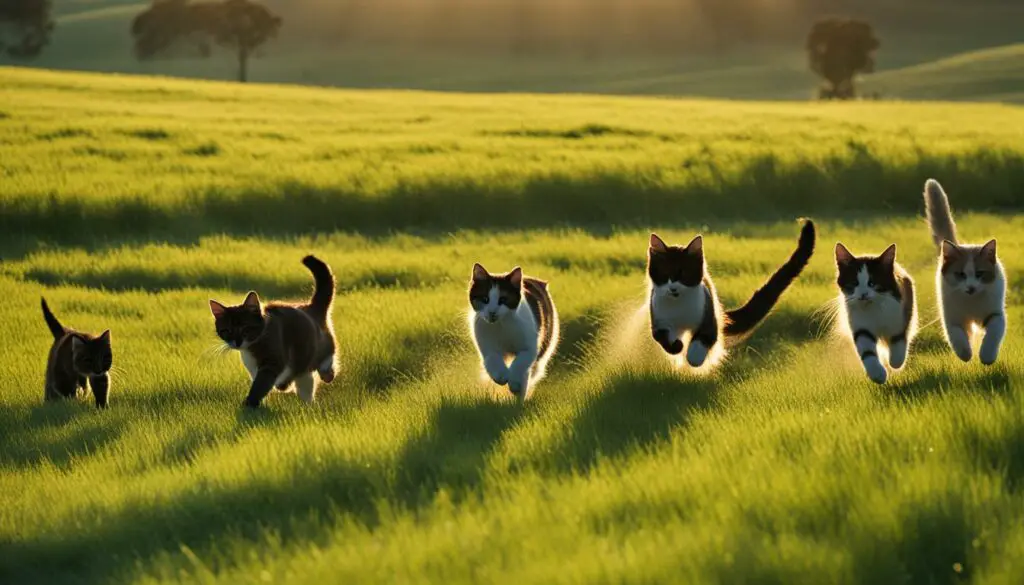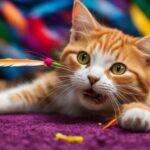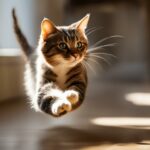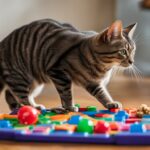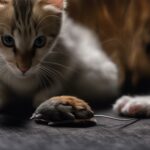As a feline enthusiast, I often wonder about the intricate behaviors of our beloved cats. One question that frequently arises is whether cats truly enjoy being chased. To delve into this intriguing topic, we need to explore their natural instincts and unique behaviors.
Cats exhibit a range of behaviors that suggest they may indeed derive pleasure from being chased. However, it’s important to note that not all cats may enjoy this type of interaction. To ensure their comfort and well-being, we must carefully observe their body language and signals.
Key Takeaways:
- Cats exhibit behaviors that suggest they enjoy being chased.
- Not all cats may enjoy being chased, so it’s important to read their body language and signals.
- Chasing stimulates play instincts and can be seen as a form of socialization and interaction for cats.
- Younger cats, certain breeds, and cats with companionship may be more receptive to play chasing.
- Safety, caution, and respecting a cat’s boundaries are essential when engaging in chasing activities.
Why Do Some Cats Like To Be Chased?
Many cats have a natural inclination to enjoy being chased. This behavior is rooted in their play instincts and is often seen as a form of socialization and interaction. When a cat enjoys being chased, they may exhibit various behaviors such as darting away, freezing, hiding, and even vocalizations. These actions are all part of a cat’s play repertoire, and they use them to invite their owners to join in the chase.
Play chasing stimulates a cat’s natural instincts and engages their predatory behavior. When a cat freezes and makes eye contact before darting away, it is an invitation for their human companion to give chase. Some cats may even hide and make vocalizations to attract attention and entice their owner to pursue them. It is essential to understand that not all cats enjoy being chased, and it is crucial to read their body language and signals to ensure they are comfortable and willing participants in the game.
“Play chasing stimulates a cat’s natural instincts and engages their predatory behavior.”
| Behavior | Description |
|---|---|
| Darting | Cats swiftly move away from their owner, encouraging them to give chase. |
| Freezing | Cats momentarily stop and make eye contact before dashing away. |
| Hiding | Cats may hide and wait for their owner to find them, signaling their readiness to play. |
| Vocalizations | Cats may meow or make other sounds to attract attention and engage their owner in the chase. |
Understanding and engaging in play chasing can be a rewarding experience for both cats and their owners. It provides physical exercise for the cat and mental stimulation as they engage their natural hunting instincts. Moreover, play chasing can strengthen the bond between a cat and their owner, promoting socialization and interaction. However, it is crucial to adjust the intensity and duration of the chase according to the cat’s comfort level and to always prioritize their safety and well-being during playtime.
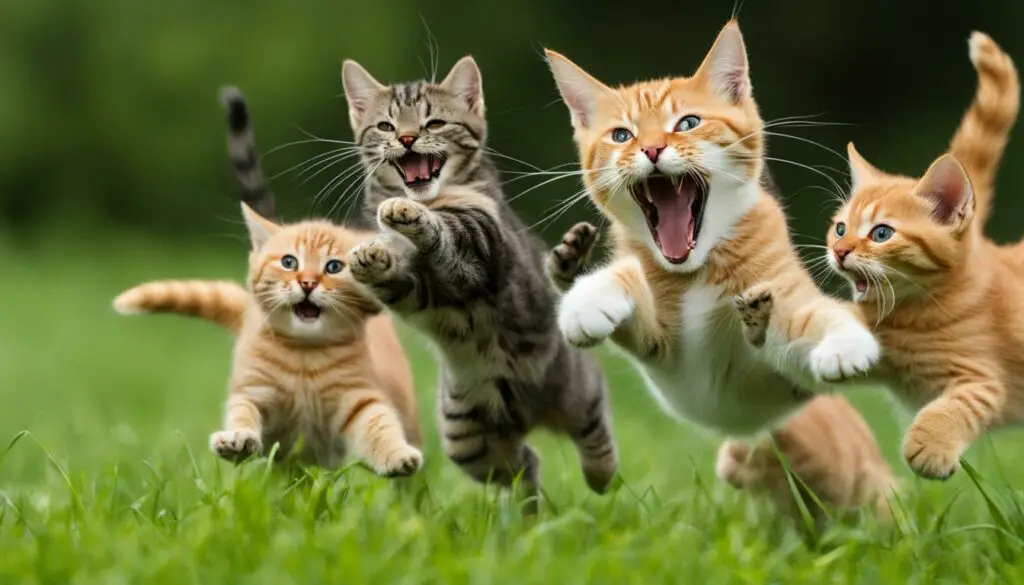
Benefits of Chasing for Cats
Chasing is not only a fun activity for cats but also offers several benefits for their overall well-being. Let’s explore the advantages that chasing brings to our feline friends:
- Agility: Chasing helps cats improve their agility and reflexes. The quick movements and changes in direction during a chase mimic the skills needed for hunting, keeping their bodies nimble and in shape.
- Stimulation: Engaging in chasing activities provides mental stimulation for cats. It keeps their minds active and helps prevent boredom, which can lead to destructive behavior.
- Exercise: Chasing is a great form of exercise for cats. It allows them to burn off excess energy and maintain a healthy weight. Regular physical activity is important for their overall physical health.
- Mental Health: The excitement and focus required during a chase can have a positive impact on a cat’s mental well-being. It provides them with a sense of purpose and fulfillment.
- Socialization: Chasing can also be a form of socialization for cats. When they engage in play chasing with their owners, it strengthens the bond between them and promotes social interaction. It can also be a great way for multiple cats in a household to bond with each other.
Overall, chasing offers numerous benefits for cats, including improved agility, mental stimulation, physical exercise, and socialization. It’s important to provide opportunities for chasing in a safe and controlled environment, ensuring that both the cat and their human companion enjoy this playful activity.
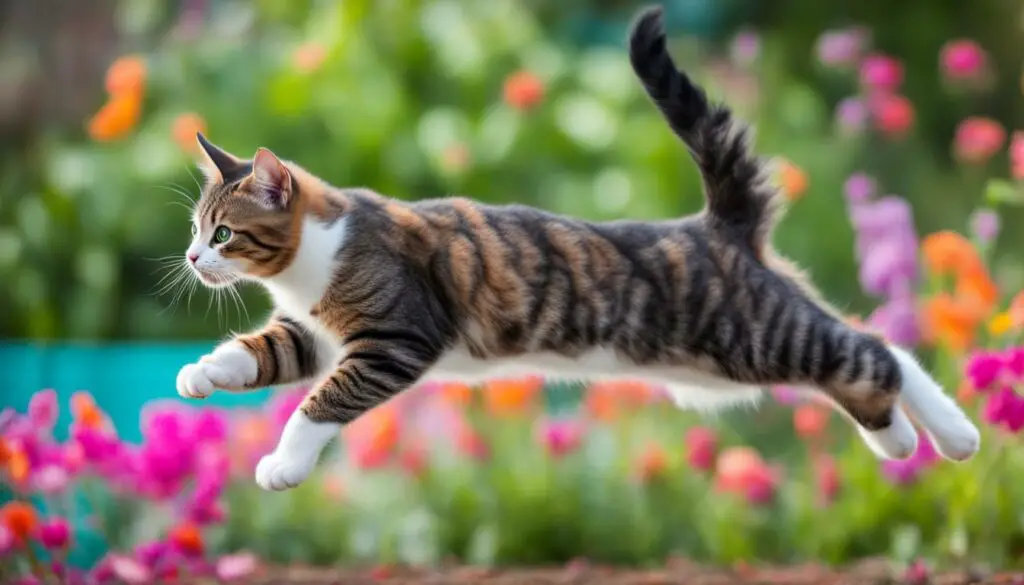
Factors Affecting a Cat’s Enjoyment of Chasing
When it comes to chasing, not all cats are the same. Several factors can influence a cat’s enjoyment of being chased, including age, breed, and the number of cats in the household.
Age
The age of a cat can play a significant role in their enjoyment of chasing. Younger cats, especially kittens, tend to be more active and playful, making them more likely to enjoy being chased by their owners. As cats age, they may become less interested in play chasing and prefer more relaxed forms of interaction.
Breed
Breed can also impact a cat’s preference for chasing. Certain breeds, such as Abyssinians and Bengals, are known for their high energy levels and love for play. These breeds are more likely to enjoy chasing games and may actively seek out opportunities to engage in this type of interaction.
Number of Cats
The number of cats in the household can influence a cat’s enjoyment of chasing. Cats that have companionship and get along well with other cats may prefer chasing each other rather than being chased by humans. They may derive more satisfaction from the social aspect of chasing with their feline companions.
Understanding these factors can help cat owners gauge their furry friend’s interest in chasing games and tailor their interactions accordingly. It’s important to respect a cat’s individual preferences and provide them with the type of play they enjoy the most.
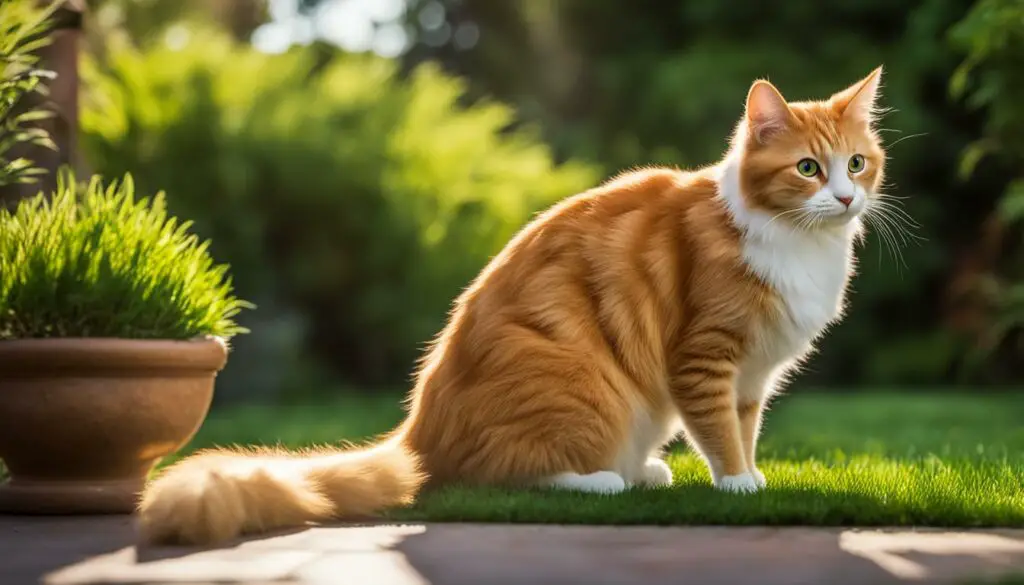
| Factors | Impact on Enjoyment of Chasing |
|---|---|
| Age | Younger cats, especially kittens, are more likely to enjoy being chased. Older cats may prefer less active forms of play. |
| Breed | Certain breeds, such as Abyssinians and Bengals, are more receptive to play chasing and may actively seek out these interactions. |
| Number of Cats | Cats that have companionship and get along with other cats may prefer chasing each other rather than being chased by humans. |
Considerations When Chasing Your Cat
When engaging in play chasing with your cat, it’s important to exercise caution and be mindful of their comfort and safety. While many cats enjoy this type of interaction, some may interpret it as aggressive behavior or become fearful. To ensure a positive and enjoyable experience for both you and your cat, here are some considerations to keep in mind:
- Read social cues: Pay attention to your cat’s body language and vocalizations. If they show signs of fear or discomfort, such as flattened ears, raised fur, hissing, or growling, it’s best to stop the chase immediately.
- Avoid overstimulation: Some cats may become overstimulated during play chasing, which can lead to aggressive behavior. Watch for signs of escalating play, such as biting or scratching, and take breaks if necessary.
- Create a safe environment: Ensure that the play area is free from hazards that could potentially harm your cat. Remove any objects that may cause injury or accidents, such as fragile items or sharp edges.
- Provide escape routes: Cats should always have a way to escape if they feel overwhelmed or need a break. Make sure there are accessible hiding spots or elevated surfaces where your cat can retreat to during the chase.
By being mindful of these considerations, you can create a positive and safe play environment for your cat. Remember, every cat is unique, so it’s important to pay attention to their individual preferences and adjust the chase accordingly. Playtime should be a fun and enjoyable experience for both you and your feline companion!

Table: Signs of Anxiety or Fear in Cats
| Signs | Description |
|---|---|
| Flattened ears | When a cat’s ears are flattened against their head, it indicates fear or anxiety. |
| Raised fur | If a cat’s fur appears puffed up or raised, it can be a sign of fear or aggression. |
| Hissing or growling | These vocalizations are often signs of fear or aggression in cats. |
| Tail flicking | When a cat’s tail is twitching or flicking rapidly, it can indicate a state of agitation or stress. |
Playing Chase with Your Cat
Playing chase with your cat can be a fun and interactive way to engage with them while providing mental and physical stimulation. It can also help tire out your cat and release pent-up energy, especially for more active and playful breeds. Additionally, playing chase can strengthen the bond between you and your cat, promoting socialization and trust.
To start playing chase with your cat, choose a safe and open space in your home where your cat can run freely without any obstacles or hazards. Use a toy or your hand to mimic the movements of prey, such as darting away or hiding behind furniture. This can entice your cat to give chase, activating their natural instincts.
During the chase, observe your cat’s body language and cues. Look for signs of enjoyment, such as an alert posture, enthusiastic movements, and playful vocalizations. If your cat starts to show signs of discomfort, such as flattening their ears, hissing, or swatting, it’s important to immediately stop the game and give them space. Every cat is unique, and their comfort levels may vary.
Remember, playing chase should always be a positive experience for both you and your cat. Be mindful of their physical limitations and avoid overexertion. Set boundaries and avoid any rough play or aggressive behaviors. By playing chase with your cat in a responsible and considerate manner, you can create a rewarding and enjoyable experience for both of you.
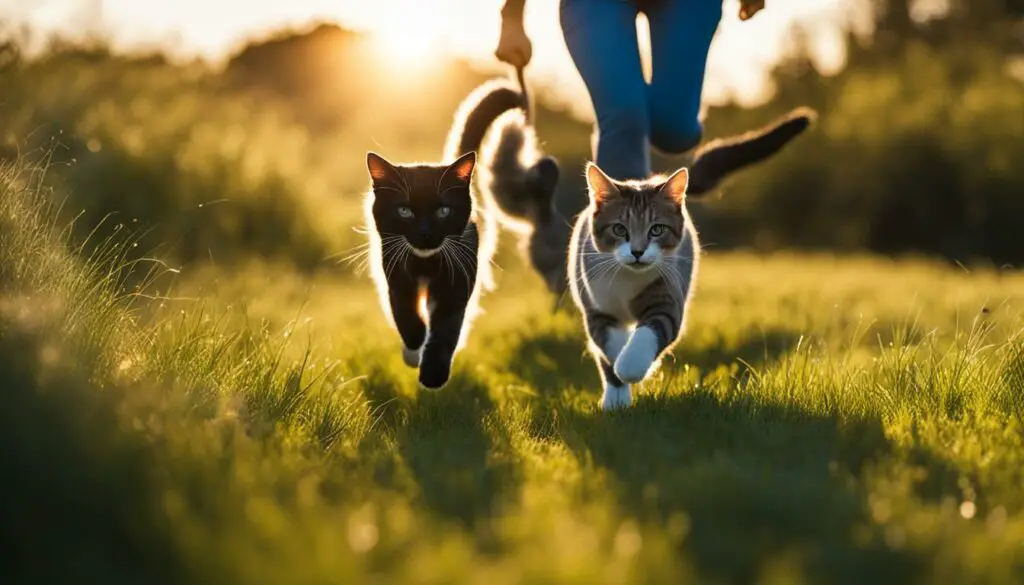
Tips for Playing Chase with Your Cat:
- Choose a safe and open space for the game, free of obstacles.
- Use a toy or your hand to mimic prey movements.
- Observe your cat’s body language for signs of enjoyment or discomfort.
- Stop the game immediately if your cat shows signs of discomfort.
- Set boundaries and avoid rough play or aggressive behaviors.
Playing Chase Table:
| Pros | Cons |
|---|---|
| Provides mental and physical stimulation | Can lead to overexertion if not monitored |
| Strengthens bond with your cat | May not be enjoyable for all cats |
| Promotes socialization and trust | Requires observation of cat’s comfort levels |
Cats and Laser Pointers
Using laser pointers as a play toy for cats can provide mental stimulation and exercise. The unpredictable movements of the laser mimic the behavior of prey, activating a cat’s natural hunting instinct. It can be a fun and engaging activity that helps keep cats entertained and physically active. However, it’s important to be mindful of potential risks and use laser pointers responsibly to ensure the safety and well-being of the cat.
While laser pointers can be a source of mental stimulation and exercise, prolonged use without closure can lead to frustration in some cats. Cats may become anxious or agitated when they are unable to “catch” the light. To avoid this, it’s recommended to provide closure by offering a physical toy that the cat can successfully capture at the end of the play session. This helps fulfill their natural hunting behavior and prevents any potential frustration or anxiety.
Additionally, it’s important to note that laser pointers should never be directed into a cat’s eyes. The laser light can cause harm and potentially damage their vision. Always be cautious and avoid shining the laser pointer directly at the cat’s face. It’s best to control the movement of the laser pointer on the ground or on walls, allowing the cat to chase and pounce on the light without any risk to their eyes.
| Pros of using laser pointers for cats | Cons of using laser pointers for cats |
|---|---|
|
|
By using laser pointers responsibly and providing closure with a physical toy, cats can enjoy the mental stimulation and exercise that laser pointer play provides. It’s important to prioritize the safety and well-being of our feline companions, ensuring that they have a positive and enjoyable play experience.
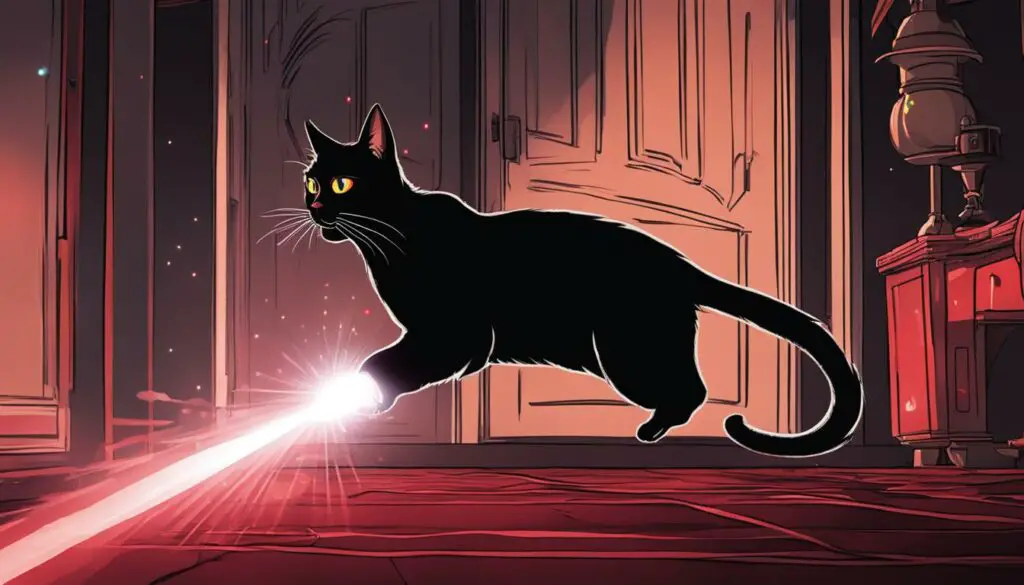
Negative Impact of Unhealthy Cat Interactions
As responsible pet owners, it is crucial for us to recognize that unhealthy interactions with our cats can have negative consequences on their well-being. Engaging in actions such as teasing, shouting, punishing, or causing physical harm to our feline companions can lead to stress, anxiety, aggression, and behavior problems.
Cats are sensitive creatures, and their mental health can be greatly affected by negative experiences. When subjected to unhealthy interactions, they may become fearful, withdrawn, or develop aggressive tendencies as a defense mechanism. These behaviors can disrupt the bond between us and our cats, making it difficult to establish trust and maintain a harmonious relationship.
Creating a safe and nurturing environment is essential for our cats’ mental health and overall well-being. It is important to treat our furry friends with kindness, respect their boundaries, and provide them with positive reinforcement and affection. By doing so, we can help them feel secure, reduce stress and anxiety, and promote a healthy and happy life for our beloved feline friends.
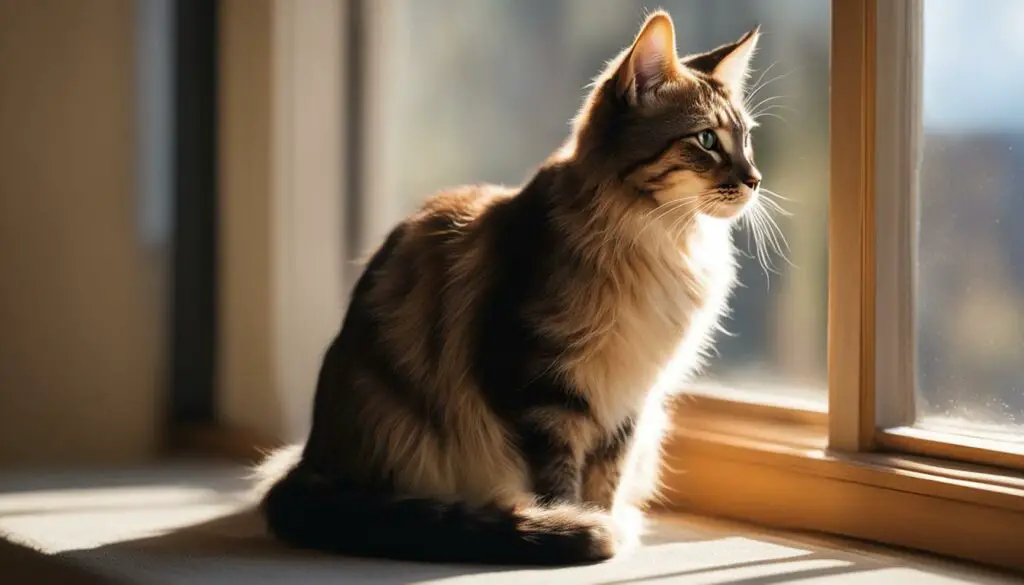
The Importance of Mental Health in Cats
Cats, like humans, can experience stress, anxiety, and other mental health issues. Negative interactions can exacerbate these problems and have long-lasting effects on their overall well-being. It is crucial for us as pet owners to be aware of the impact our actions can have and to prioritize our cats’ mental health.
By providing a loving and supportive environment, engaging in positive play interactions, and seeking professional help if needed, we can help our cats overcome any negative effects of unhealthy interactions. It is our responsibility to ensure that our cats feel safe, loved, and valued members of our families.
Paying Attention to Your Cat’s Needs
As responsible cat owners, it is essential to pay close attention to our feline companions’ needs. This involves more than just providing food and shelter; it also means attending to their physical and emotional well-being. Here are some key areas to focus on when ensuring your cat’s needs are met:
Grooming
Regular grooming is not only beneficial for your cat’s physical appearance but also for their overall health. Brushing their fur helps to remove loose hair, preventing matting and reducing the risk of hairballs. Additionally, grooming sessions offer an opportunity for you to bond with your cat and provide them with much-needed affection and attention.
Pain Detection
Cats are masters at hiding their pain, making it crucial for us to be vigilant and observant. Regularly check your cat for any signs of discomfort, such as limping, changes in appetite, or excessive grooming of a particular area. If you suspect that your cat may be in pain, it is important to consult with a veterinarian promptly to ensure proper diagnosis and treatment.
Mental Stimulation
Keeping your cat mentally stimulated is vital for their overall well-being. Provide them with plenty of toys that encourage interactive play and engage their natural instincts. Puzzle toys or treat-dispensing toys can also provide mental stimulation as they challenge your cat’s problem-solving abilities. Additionally, setting up a designated space with scratching posts, climbing trees, and hiding spots allows your cat to explore and satisfy their curiosity.
Affection and Interaction
Just like humans, cats thrive on affection and social interaction. Take the time to cuddle, pet, and play with your cat daily to fulfill their need for companionship. Engage in interactive play sessions using toys or laser pointers, and provide opportunities for them to explore their surroundings under your watchful eye. Remember, quality time spent together strengthens the bond between you and your feline companion.
| Grooming | Pain Detection | Mental Stimulation | Affection and Interaction |
|---|---|---|---|
| Regular brushing Prevents matting and hairballs Bonding time |
Vigilance and observation Check for signs of discomfort Prompt veterinary consultation |
Provide interactive toys Puzzle toys and treat-dispensers Designated play area |
Cuddle and pet daily Engage in interactive play sessions Offer opportunities for exploration |
Potential Risks of Laser Pointer Play
Playing with laser pointers can be a fun and engaging activity for both cats and their owners. However, it’s important to be aware of potential risks associated with this type of play. One of the primary concerns is eye safety. Directing the laser pointer into a cat’s eyes can cause harm and potentially lead to eye injuries. To mitigate this risk, it’s crucial to avoid shining the light directly at the cat’s face and instead focus it on the ground or other safe surfaces.
Another potential risk is an increase in aggression or anxiety in some cats. The unpredictable movement of the laser pointer can trigger a cat’s hunting instincts, but if they are unable to catch the light, it may lead to frustration and agitation. In some cases, this can manifest as increased aggression towards both humans and other animals. Additionally, excessive play with laser pointers has been associated with the development of anxiety and paranoia in certain individuals.
To ensure the well-being of your feline companion, it’s recommended to use laser pointers in moderation and as part of a balanced play routine. Alternate with other interactive toys and activities that provide physical exercise and mental stimulation. If you notice any signs of aggression or anxiety in your cat after playing with a laser pointer, it’s best to discontinue the activity and consult with a veterinarian or a professional animal behaviorist for guidance.
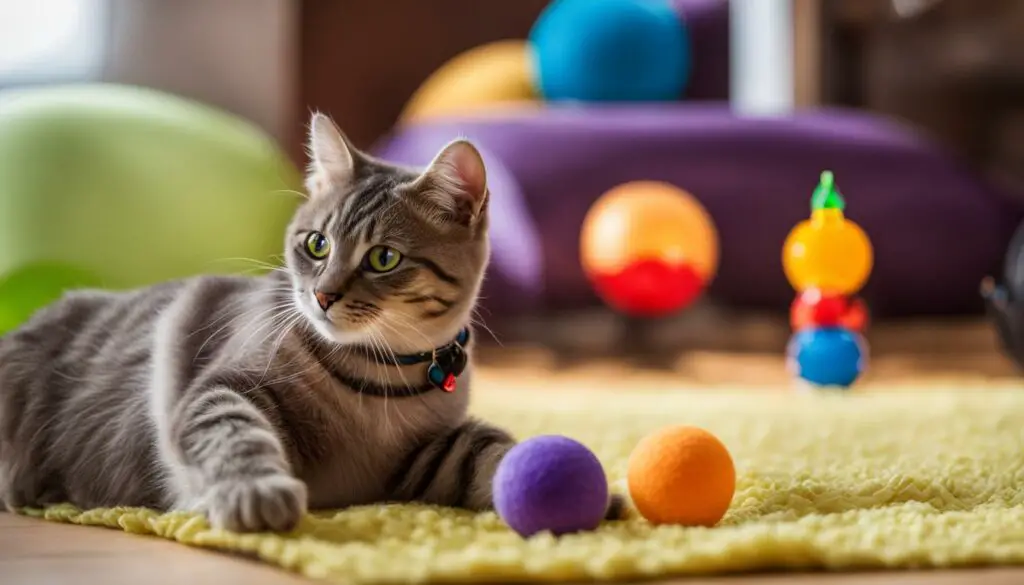
The Potential Risks of Laser Pointer Play
| Potential Risks | Preventive Measures |
|---|---|
| Eye Safety | Avoid shining the laser pointer directly into the cat’s eyes and focus it on safe surfaces. |
| Increased Aggression | Monitor the cat’s behavior closely and discontinue the play if signs of aggression arise. |
| Anxiety and Paranoia | Use laser pointers in moderation and provide other forms of play and mental stimulation. |
Importance of Positive Play Interaction
Creating positive play interaction with your cat is crucial for their mental well-being and physical health. Engaging in enjoyable play activities strengthens the bond between you and your feline companion, fostering trust and deepening your relationship.
Play is a natural behavior for cats, and it provides them with mental stimulation and physical exercise. Through play, cats can release energy, fulfill their hunting instincts, and keep their minds sharp. Positive play interaction helps prevent boredom and the development of destructive behavior.
When engaging in play with your cat, it’s important to provide them with toys that cater to their natural instincts, such as interactive toys that mimic prey. These toys can include feather wands, toy mice, or puzzle toys that dispense treats. The variety of toys available ensures that your cat remains engaged and interested during play sessions.
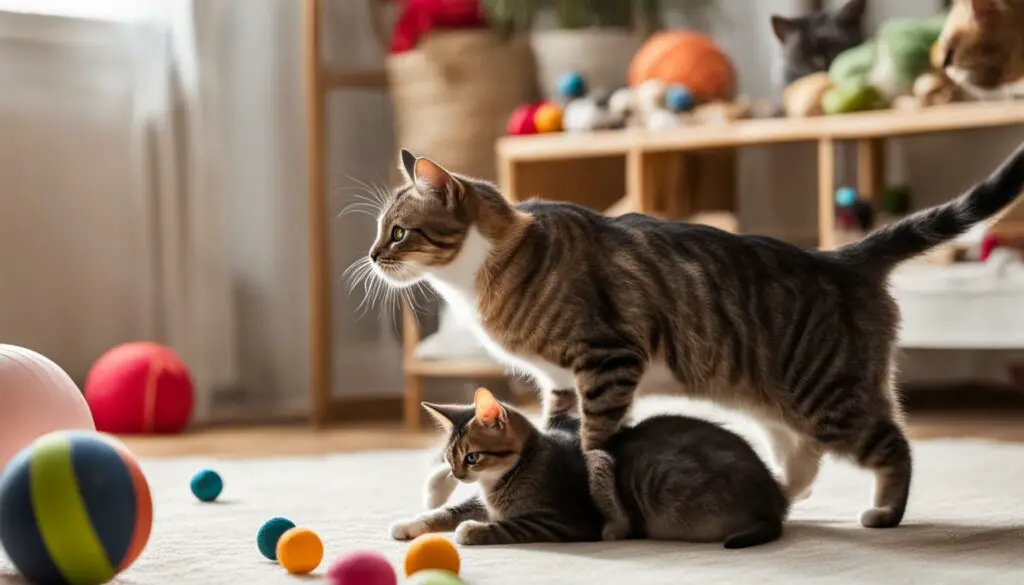
It’s also important to observe your cat’s body language and cues during play. Pay attention to their level of enthusiasm and ensure that they are comfortable and not overstimulated. Cats may display signs of excitement, such as dilated pupils, twitching tails, and focused attention, when they are enjoying play. However, if you notice signs of discomfort, such as flattened ears, hissing, or swatting, it’s essential to stop the play session and give your cat some space.
Positive play interaction not only provides physical and mental benefits for your cat but also strengthens the bond between you. Use playtime as an opportunity to show your cat affection and provide them with attention and reassurance. By engaging in enjoyable play activities, you are fostering a sense of trust and creating a nurturing environment for your cat.
Understanding Cat Behavior and Body Language
Understanding cat behavior and body language is essential for effective communication and interaction with your feline companion. Cats communicate through a combination of vocalizations, body postures, and social cues, providing valuable insights into their emotions and intentions.
Vocalizations: Cats use a range of sounds to express themselves. Meowing, purring, hissing, and yowling are some of the common vocalizations you may hear. Each sound carries a specific meaning, like meowing for attention or purring to show contentment. By listening to their vocalizations, you can better understand your cat’s needs and emotions.
Body Posture: Cats communicate through their body postures, which can convey various messages. A relaxed and open posture indicates that the cat is comfortable and approachable. On the other hand, a tense body, raised fur, or arched back may suggest fear, aggression, or discomfort. By observing your cat’s body language, you can better gauge their mood and respond accordingly.
Social Cues: Cats also use social cues to communicate with humans and other animals. They may rub against you, knead their paws, or gently headbutt you as signs of affection and bonding. Tail movements, such as a straight-up tail indicating confidence or a tail tucked between the legs indicating fear, can provide valuable insights into their emotional state. Paying attention to these cues helps establish trust and strengthen your bond with your cat.
Common Cat Body Language Signals:
- Tail position: A straight-up tail indicates confidence, while a tucked tail suggests fear or anxiety.
- Piloerection: Raised fur along the cat’s back indicates heightened arousal or aggression.
- Purring: Purring signifies contentment and relaxation.
- Ear position: Ears facing forward indicate an alert and curious cat, while flattened ears suggest fear or aggression.
- Eye dilation: Dilated pupils can indicate excitement, fear, or aggression.
Understanding and interpreting your cat’s behavior and body language allows for better communication and a deeper connection with your feline friend. By being attentive to their vocalizations, body postures, and social cues, you can respond appropriately to their needs and create a harmonious environment for both of you.
| Body Language Signal | Meaning |
|---|---|
| Tail position | A straight-up tail indicates confidence, while a tucked tail suggests fear or anxiety. |
| Piloerection | Raised fur along the cat’s back indicates heightened arousal or aggression. |
| Purring | Purring signifies contentment and relaxation. |
| Ear position | Ears facing forward indicate an alert and curious cat, while flattened ears suggest fear or aggression. |
| Eye dilation | Dilated pupils can indicate excitement, fear, or aggression. |
Understanding your cat’s behavior and body language is a crucial aspect of responsible pet ownership. It allows you to establish a strong bond, provide appropriate care, and respond effectively to their needs. By paying attention to their communication signals, you can create a harmonious and fulfilling relationship with your feline companion.
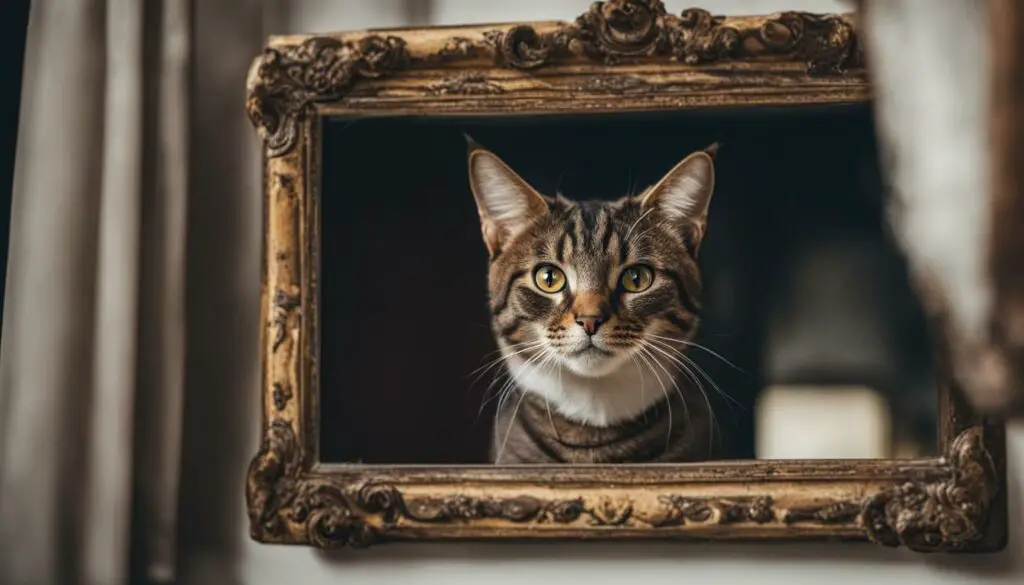
Responsible Pet Ownership
As a responsible pet owner, it is important to prioritize the well-being of your cat in various aspects of their life. This includes providing proper grooming, healthcare, nutrition, and ensuring a safe environment for them to thrive in. By focusing on these key areas, you can contribute to your cat’s overall health and happiness.
Grooming
Grooming plays a crucial role in maintaining your cat’s hygiene and overall well-being. Regular brushing helps to remove loose hair, prevent matting, and keep their coat clean and healthy. Additionally, it allows you to check for any signs of skin issues, fleas, or ticks. Remember to use appropriate grooming tools and techniques, and be gentle to ensure a positive experience for your cat.
Healthcare
Proper healthcare is essential for keeping your cat healthy and preventing illness. Regular veterinary check-ups, vaccinations, and preventative treatments for fleas, ticks, and parasites are crucial. It’s important to be proactive in addressing any health concerns or changes in behavior that may indicate an underlying issue. By staying up-to-date with your cat’s healthcare needs, you can provide them with the best possible care.
Nutrition
A balanced and nutritious diet is vital for your cat’s overall health and well-being. Providing high-quality cat food that meets their nutritional requirements is essential. Consult with your veterinarian to determine the appropriate type and amount of food for your cat based on factors such as age, breed, and any specific dietary needs they may have. Additionally, ensure fresh water is always available for your cat to stay hydrated.
Environment and Safety
Creating a safe and enriching environment is crucial for your cat’s physical and mental well-being. Ensure that your home is free from hazards such as toxic plants, chemicals, and small objects that can be swallowed. Provide your cat with appropriate toys and scratching posts to keep them mentally stimulated and physically active. Additionally, establish a designated area where your cat can retreat and feel safe. Regularly inspect your home to identify and address any potential safety concerns.
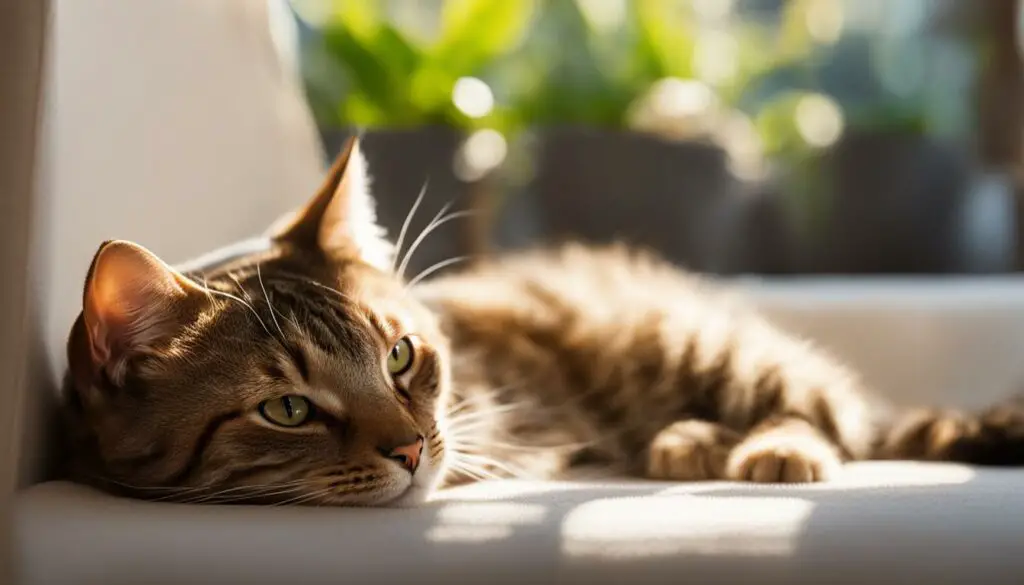
| Key Elements of Responsible Pet Ownership |
|---|
| Create a safe and enriching environment |
| Regular grooming to maintain hygiene |
| Provide appropriate healthcare, including vaccinations and check-ups |
| Offer a balanced and nutritious diet |
In conclusion, responsible pet ownership involves taking care of all aspects of your cat’s life, including grooming, healthcare, nutrition, and providing a safe environment. By prioritizing these areas and meeting your cat’s needs, you can ensure their overall health, happiness, and well-being.
Recognizing Individual Preferences
When it comes to play and social interaction, cats have their own unique preferences. Some cats may enjoy independence and prefer solitary play, while others thrive on companionship and crave bonding with their owners. Recognizing and respecting these individual preferences is crucial for fostering a positive and mutually beneficial relationship with your feline friend.
Cats that enjoy independence may engage in solitary play, entertaining themselves with toys and exploring their surroundings. They may appreciate having their own quiet space where they can retreat and recharge. On the other hand, cats that seek companionship may actively seek attention, affection, and interaction from their owners. They may enjoy playing interactive games together or simply lounging in close proximity to their favorite humans.
Understanding your cat’s individual preferences can help you tailor your interaction accordingly. Pay attention to their body language and cues to determine what they enjoy and what makes them uncomfortable. Some cats may prefer gentle strokes and cuddles, while others may be more inclined to engage in active play. By respecting their boundaries and providing the level of interaction they desire, you can build a stronger bond and create a harmonious environment for both of you.
Fostering a Balanced Approach
While it’s important to recognize and respect your cat’s individual preferences, it’s also essential to foster a balanced approach. This means providing opportunities for both independent play and interactive bonding time. By offering a variety of toys and activities, you can cater to your cat’s need for mental stimulation and physical exercise, regardless of their preference for solitary or social play.
Incorporate interactive toys, such as puzzle feeders or wand toys, into your cat’s playtime routine to keep them mentally engaged and physically active. This can be especially beneficial for cats that lean towards independence, as it provides them with opportunities for solo play that simulate hunting behaviors. Additionally, setting aside dedicated one-on-one bonding time with your cat can help strengthen your relationship and provide the social interaction they crave.
By recognizing and accommodating your cat’s individual preferences while fostering a balanced approach to play and socialization, you can ensure that both you and your feline companion enjoy a fulfilling and mutually satisfying relationship.
| Play Preference | Characteristics |
|---|---|
| Independent Play | Engages in solitary play |
| Enjoys exploring and entertaining themselves | |
| Appreciates having their own quiet space | |
| Companionship | Seeks attention and affection from owners |
| Enjoys interactive play and bonding time | |
| Thrives on close proximity to their favorite humans |
Remember, every cat is unique, and their preferences may evolve over time. By observing their behavior, listening to their cues, and providing a variety of play and socialization opportunities, you can create an environment that caters to their individual needs and strengthens your bond.
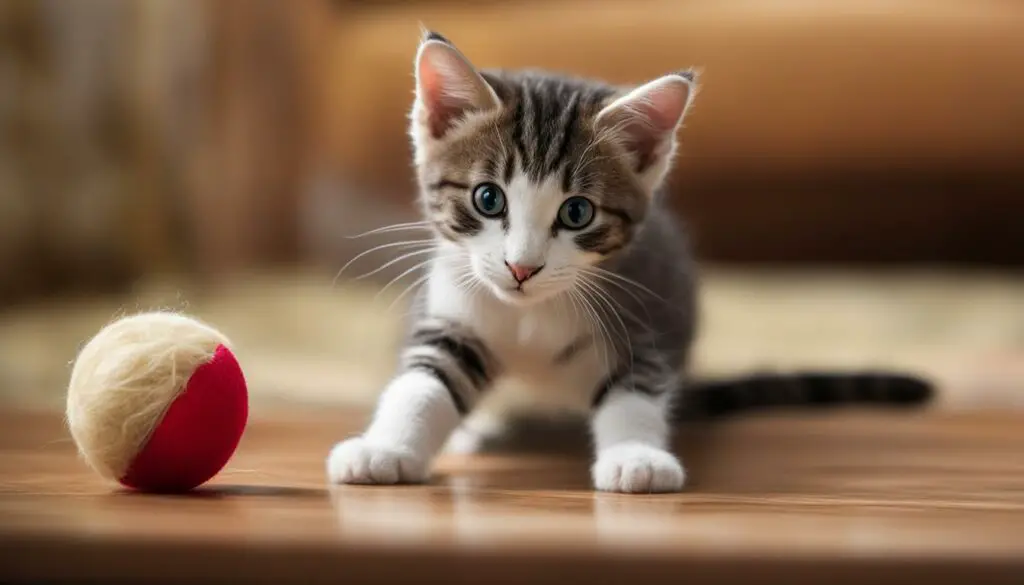
Providing an Enriching Environment
Creating an enriching environment for our feline friends is essential for their overall well-being. As playful creatures, cats thrive in an environment that stimulates their natural instincts and provides opportunities for mental stimulation and physical exercise.
Toys play a crucial role in keeping cats entertained and engaged. Choose a variety of toys that cater to their playfulness and curiosity. Interactive toys, such as puzzle toys or treat-dispensing toys, can provide mental stimulation while satisfying their hunting instincts. Toys that mimic prey, like feather wands or small mice toys, can also be enticing for cats to chase and pounce on.
Establishing boundaries is equally important when providing an enriching environment. Cats need designated areas where they can scratch and climb without damaging furniture. Invest in sturdy scratching posts or cat trees to fulfill their natural desire to stretch, sharpen their claws, and climb to higher vantage points. These designated spaces not only serve as outlets for physical exercise but also help cats feel secure and confident in their environment.
Creating a Stimulating Indoor Environment
- Provide vertical spaces: Install shelves or cat perches at different heights to encourage climbing and provide elevated resting spots.
- Create hiding spots: Use cardboard boxes or tunnels to provide hiding places where cats can retreat and feel safe.
- Offer window views: Position perches near windows to allow cats to observe the outside world, stimulating their natural curiosity.
- Rotate toys: Keep toys fresh and exciting by rotating them regularly. This prevents boredom and ensures continued engagement.
- Use catnip and interactive toys: Catnip can be an excellent way to stimulate playfulness and encourage cats to interact with toys. Interactive toys, such as laser pointers or feather wands, can also provide mental and physical exercise.
Remember, each cat is unique, and their preferences may vary. Observe your cat’s behavior and provide toys and activities that align with their interests. By creating an enriching environment, you can promote a healthy and fulfilled life for your feline companion.
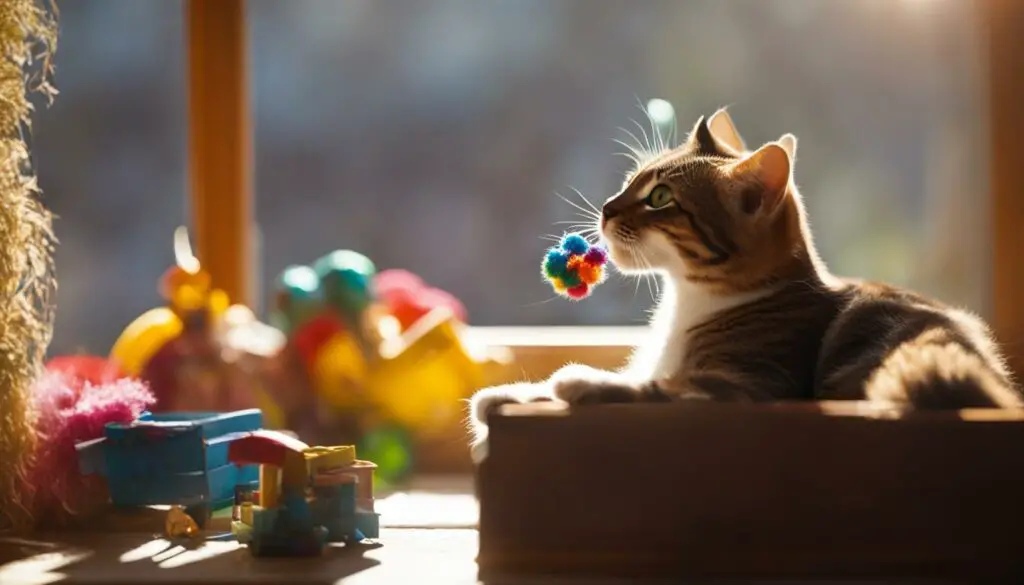
Conclusion
In conclusion, understanding cat behavior and providing mental stimulation is essential for responsible pet ownership. Many cats enjoy play chasing as it stimulates their natural instincts and provides mental exercise. However, it’s important to recognize that not all cats may enjoy being chased and it’s crucial to read their body language and signals to ensure their comfort and enjoyment.
Creating an enriching environment with appropriate toys and boundaries can prevent boredom and destructive behavior, while also promoting a healthy and fulfilled life. Responsible pet ownership involves regular grooming, healthcare, and nutrition to maintain a cat’s well-being. By providing a stimulating and safe environment, practicing positive play interaction, and respecting a cat’s individual preferences, a strong bond and trust can be built between owners and their feline companions.
Remember, each cat is unique, and understanding their needs and preferences is key to fostering a happy and healthy relationship. So, engage in play activities that your cat enjoys, be attentive to their body language, and provide mental stimulation to keep them mentally sharp and physically active. By being a responsible and caring pet owner, you can ensure a fulfilling life for your beloved feline friend.
FAQ
Do cats enjoy being chased?
Many cats enjoy being chased because it stimulates their play instincts and provides socialization and interaction. However, not all cats may enjoy being chased, so it’s important to read their body language and signals to ensure their comfort.
Why do some cats like to be chased?
Cats enjoy being chased because it activates their play instincts. They may freeze, make eye contact, and then dart away, inviting their owner to give chase. Play chasing allows cats to improve their agility, provides mental stimulation, and can be a form of socialization.
What are the benefits of chasing for cats?
Chasing allows cats to improve their agility and reflexes, providing physical exercise and mental stimulation. It also promotes socialization and bonding with their owners and provides an outlet for their natural play instincts.
What factors affect a cat’s enjoyment of chasing?
Age, breed, and the number of cats in the household can influence a cat’s enjoyment of chasing. Younger cats and certain breeds, such as Abyssinians and Bengals, are generally more receptive to play chasing. Cats that have companionship and get along with other cats may prefer chasing each other rather than being chased by humans.
What should I consider when chasing my cat?
It’s important to exercise caution and read your cat’s social cues. Some cats may interpret chasing as aggressive behavior and become fearful or aggressive themselves. Avoid overstimulation and watch for signs of anxiety or discomfort. Safety should always be a priority, and create a secure environment where the cat can escape if needed.
Why is playing chase with my cat beneficial?
Playing chase with your cat is a fun and beneficial activity. It can help tire them out, release pent-up energy, strengthen the bond between you and your cat, promote socialization, and provide mental and physical stimulation.
What should I know about cats and laser pointers?
Laser pointers can be a source of mental stimulation and exercise for cats. However, it’s important to use them responsibly to avoid potential negative effects on a cat’s behavior. Some cats may become frustrated or anxious when they can’t catch the light, leading to aggression or compulsive behavior. It’s important to provide closure by offering a physical toy for the cat to “catch” after using a laser pointer.
What negative impacts can unhealthy cat interactions have?
Unhealthy cat interactions, such as teasing, shouting, punishing, or physical harm, can cause stress, anxiety, and aggression in cats. This can lead to behavior problems and a decline in their mental health. It’s important to treat cats with kindness, respect their boundaries, and provide a safe and nurturing environment.
How should I take care of my cat’s needs?
Regular grooming, checking for physical discomfort, providing mental stimulation, affection, attention, and interaction are crucial for a cat’s well-being. Each cat is unique, so understanding their preferences and fulfilling their needs is essential for a healthy cat-human relationship.
What are the potential risks of laser pointer play?
Laser pointers can be entertaining for cats, but it’s important to be mindful of the potential risks. Directing the laser into a cat’s eyes can cause harm, so avoid shining the light directly at their face. Laser pointer play may also lead to increased aggression or anxiety in some cats. If a cat becomes anxious after playing with a laser pointer, it’s best to discontinue the activity.
Why is positive play interaction important for cats?
Positive play interaction is essential for a cat’s mental well-being and physical health. Engaging in enjoyable play activities strengthens the bond between you and your cat, builds trust, and provides mental and physical stimulation.
How can I understand cat behavior and body language?
Cats communicate through signals such as vocalizations, body postures, and facial expressions. Understanding these cues helps determine if a cat is enjoying play or feeling anxious or overwhelmed. Respecting a cat’s boundaries and adjusting play accordingly is important.
What does responsible pet ownership entail?
Responsible pet ownership involves proper grooming, healthcare, nutrition, and a safe environment for cats. Regular veterinary check-ups and vaccinations are crucial. Creating a stimulating and safe environment with appropriate toys and boundaries ensures a cat’s mental and physical well-being.
How can I recognize my cat’s individual preferences?
Cats have individual preferences for play and social interaction. Some may prefer solitary play, while others enjoy companionship and attention. Understanding their unique personality and providing the level of interaction and attention they desire is important for a positive relationship.
How can I provide an enriching environment for my cat?
Providing a variety of toys that encourage playfulness and mental stimulation prevents boredom and destructive behavior. Setting boundaries and offering outlets for physical exercise, such as scratching posts and climbing trees, satisfy a cat’s natural instincts and promote a healthy and fulfilled life.

